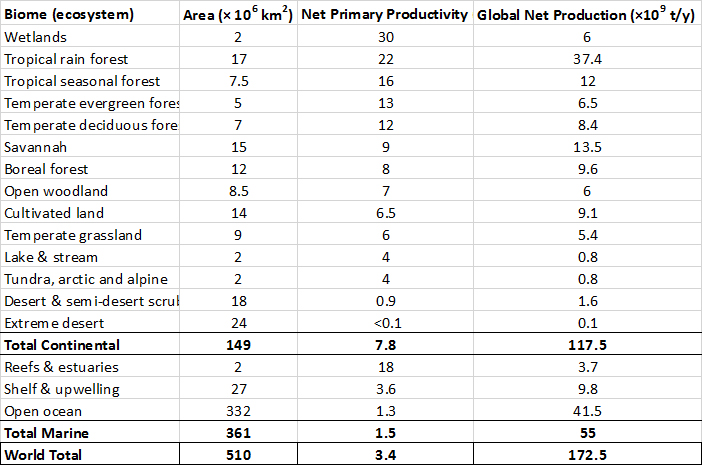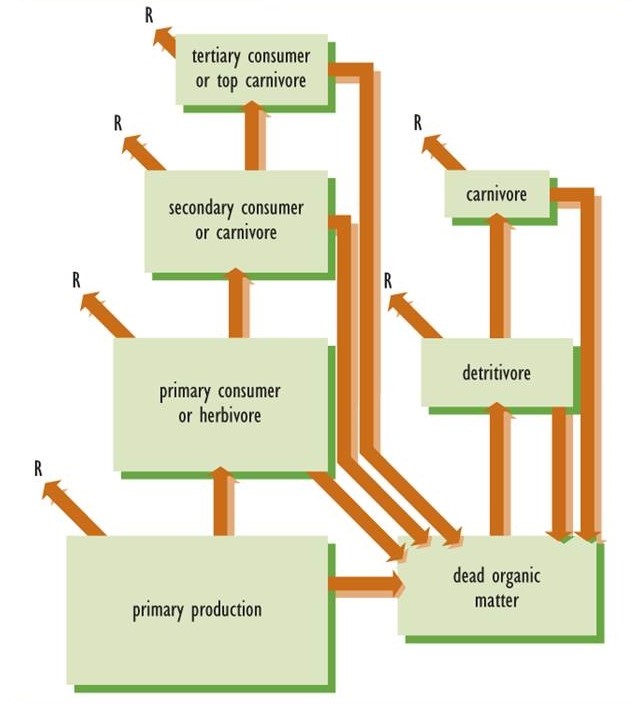Why Must Ecosystems Receive a Continuous Supply of Energy From the Sun
Chapter 4 ~ Energy and Ecosystems
Key Concepts
- Describe the nature of energy, its various forms, and the laws that govern its transformations.
- Explain how Earth is a flow-through system for solar energy.
- Identify the three major components of Earth's energy budget.
- Describe energy relationships within ecosystems, including the fixation of solar energy by primary producers and the passage of that fixed energy through other components of the ecosystem.
- Explain why the trophic structure of ecological productivity is pyramid-shaped and why ecosystems cannot support many top predators.
- Compare the feeding strategies of humans living a hunting and gathering lifestyle with those of modern urban people.
Introduction
The Nature of Energy
- A hockey stick strikes a puck, causing it to speed toward a target
- A book is picked up from the floor, lifted, and then laid on a table
- A vehicle is driven along a road
- Heat from a stove is absorbed by water in a kettle, causing it to become hotter and eventually to boil
- The photosynthetic pigment chlorophyll absorbs sunlight, converting the electromagnetic energy into a form that plants and algae can utilize to synthesize sugars
Electromagnetic Energy
Kinetic Energy
Potential Energy
- Chemical potential energy is stored in the molecular bonds of sulphide minerals, such as iron sulphide (FeS2), and some of this energy is released when the sulphides are oxidized. Specialized bacteria can metabolically tap the potential energy of sulphides to support their own productivity, through a process known as chemosynthesis (this is further examined later in this chapter).
- The ionic bonds of salts also store chemical potential energy. For example, when sodium chloride (table salt, NaCl) is dissolved in water, ionic potential energy is released as heat, which slightly increases the water temperature.
- Hydrocarbons store energy in the bonds between their hydrogen and carbon atoms (hydrocarbons contain only these atoms). The chemical potential energy of gasoline, a mixture of liquid hydrocarbons, is liberated in an internal combustion engine and becomes mechanically transformed to achieve the kinetic energy of vehicular motion.
- Organic compounds (biochemicals) produced metabolically by organisms also store large quantities of potential energy in their inter-atomic bonds. The typical energy density of carbohydrates is about 16.8 kJ/g, while that of proteins is 21.0 kJ/g, and lipids (or fats) 38.5 kJ/g. Many organisms store their energy reserves as fat because these biochemicals have such a high energy density.
Units of Energy
Energy Transformations
The First Law of Thermodynamics
The Second Law of Thermodynamics
Earth: An Energy Flow-Through System
Earth's Energy Budget
Energy in Ecosystems
Conclusions
Questions for Review
- What forms of energy are described in this chapter? How can each be changed into other forms?
- What are the first and second laws of thermodynamics? How do they govern transformations of energy?
- What are the major elements of Earth's physical energy budget?
- Why is the trophic structure of ecological productivity pyramid-shaped?
Questions for Discussion
- According to the second law of thermodynamics, systems always spontaneously move toward a condition of greater entropy. Yet life and ecosystems on Earth represent local systems where negative entropy is continuously being generated. What conditions allow this apparent paradox to exist?
- Why are there no natural higher-order predators that kill and eat lions, wolves, and sharks?
- Why would it be more efficient for people to be vegetarian? Discuss your answer in view of the pyramid-shaped structure of ecological productivity.
- Make a list of the key sources and transformations of energy that support you and your activities on a typical day. What is the ultimate source of each of the energy resources you use (such as sunlight and fossil fuels)?
Exploring Issues
- As part of a study of the cycling of pollutants, you have been asked to describe the food web of two local ecosystems. One of the ecosystems is a natural forest (or prairie) and the other is an area used to grow wheat (or another crop). How would you determine the major components of the food webs of these ecosystems, the species occurring in their trophic levels, and the interactions among the various species that are present?
References Cited and Further Reading
Source: https://digitaleditions.library.dal.ca/environmentalscience/chapter/chapter-4-energy-and-ecosystems/


0 Response to "Why Must Ecosystems Receive a Continuous Supply of Energy From the Sun"
Post a Comment